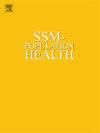20年的老年人临终状况:年龄更大,寿命更长?
IF 3.1
2区 医学
Q1 PUBLIC, ENVIRONMENTAL & OCCUPATIONAL HEALTH
引用次数: 0
摘要
背景:过去几十年死亡率的下降推迟了死亡年龄。老年死亡可能涉及生命终结时健康轨迹的改变。这项研究调查了死亡前3个月至3天的10年间健康状况的水平差异和变化。癌症和非癌症死者之间的区别,因为他们的轨迹是不同的。方法数据由荷兰人口纵向老龄化研究阿姆斯特丹参与者的代理提供,这些参与者在2005-2009年(2008年中)和2017-2019年(2018年中)期间死亡,分别有162名和124名死者的完整数据。健康状况包括功能受限、症状严重和意识低下。结果平均死亡年龄由2008年的81.0岁上升至2018年的83.5岁。48%的死者是男性。癌症占死亡原因的33%。控制性别、死亡年龄和教育程度,2018年非癌症死者在死亡前3个月的意识低下的情况比2008年更多。2018年3个月时,癌症患者经历的功能限制比2008年少,比非癌症患者少。在这两个时期,癌症患者比非癌症患者经历了更严重的功能衰退。在这两个时期,癌症患者和非癌症患者的症状严重程度轨迹相似。2018年,非癌症患者(而非癌症患者)的死亡过程比2008年更长。癌症患者和非癌症患者的症状严重程度和加重程度并没有随着时间的推移而改善,这表明两组患者都需要改善姑息治疗。本文章由计算机程序翻译,如有差异,请以英文原文为准。
Two decades of end-of-life conditions of older adults: older and more protracted?
Background
The mortality decline during the past decades has postponed the age at death. Dying at older ages may involve alterations in health trajectories at the end of life. This study examined 10-year period differences in level and changes in health conditions from 3 months to 3 days before death. Distinction was made between cancer and non-cancer decedents, because their trajectories are known to differ.
Methods
Data were provided by proxies of participants in the Dutch population-based Longitudinal Aging Study Amsterdam, who died between 2005–2009 (midyear 2008) and 2017–2019 (midyear 2018), with complete data for 162 and 124 decedents, respectively. Health conditions included functional limitations, symptom severity, and low consciousness.
Results
Average age at death increased from 81.0 (2008) to 83.5 (2018). 48 % of decedents were men. Cancer constituted 33 % of causes of death. Controlling for sex, age at death, and education, non-cancer decedents experienced more often low consciousness at 3 months before death in 2018 than in 2008. At 3 months in 2018, cancer decedents experienced fewer functional limitations than in 2008 and fewer than non-cancer decedents. In both periods, cancer decedents experienced steeper functional declines than non-cancer decedents. Trajectories of symptom severity were similar in cancer and non-cancer decedents in both periods.
Discussion
In non-cancer decedents, but not in cancer decedents, the dying process was more protracted in 2018 than in 2008. Level and increase in symptom severity did not improve over time for both cancer and non-cancer decedents, suggesting that improvement of palliative care is warranted for both groups.
求助全文
通过发布文献求助,成功后即可免费获取论文全文。
去求助
来源期刊

Ssm-Population Health
PUBLIC, ENVIRONMENTAL & OCCUPATIONAL HEALTH-
CiteScore
6.50
自引率
2.10%
发文量
298
审稿时长
101 days
期刊介绍:
SSM - Population Health. The new online only, open access, peer reviewed journal in all areas relating Social Science research to population health. SSM - Population Health shares the same Editors-in Chief and general approach to manuscripts as its sister journal, Social Science & Medicine. The journal takes a broad approach to the field especially welcoming interdisciplinary papers from across the Social Sciences and allied areas. SSM - Population Health offers an alternative outlet for work which might not be considered, or is classed as ''out of scope'' elsewhere, and prioritizes fast peer review and publication to the benefit of authors and readers. The journal welcomes all types of paper from traditional primary research articles, replication studies, short communications, methodological studies, instrument validation, opinion pieces, literature reviews, etc. SSM - Population Health also offers the opportunity to publish special issues or sections to reflect current interest and research in topical or developing areas. The journal fully supports authors wanting to present their research in an innovative fashion though the use of multimedia formats.
 求助内容:
求助内容: 应助结果提醒方式:
应助结果提醒方式:


